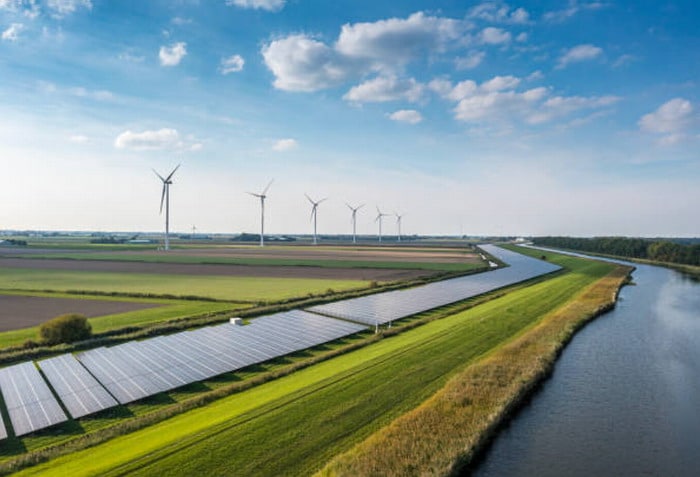What is the Environmental Impact of Solar Energy?

As the world turns its attention to cleaner and more sustainable sources of energy, solar power has emerged as a shining star in the renewable energy landscape. Harnessing the power of the sun, solar energy offers numerous benefits, including reducing greenhouse gas emissions and lessening our reliance on fossil fuels. However, as with any energy source, there are environmental considerations to explore. In this article, we will delve into the environmental impact of solar energy, examining both its positive and negative effects on our planet. Let’s see what is the environmental impact of solar energy.
The Bright Side: Positive Environmental Impacts
1. Reduced Greenhouse Gas Emissions
One of the most significant environmental benefits of solar energy is its role in reducing greenhouse gas emissions. Solar panels generate electricity without producing carbon dioxide (CO2) or other harmful pollutants, helping to combat climate change.
2. Air Quality Improvement
Solar energy systems do not release pollutants into the air, which means cleaner and healthier air for all. This leads to fewer respiratory and cardiovascular issues and a better quality of life for communities.
3. Low Water Usage
Unlike conventional power plants that rely on water for cooling, solar panels use minimal water. This water efficiency is crucial in regions facing water scarcity.
4. Land Use and Biodiversity
Solar farms can often coexist with agriculture or provide habitat for native plants and animals, preserving biodiversity in some areas.
5. Energy Independence
Solar energy reduces the dependence on fossil fuels and foreign energy sources, contributing to national energy security.
The Shadows: Challenges and Concerns
1. Manufacturing and E-Waste
The production of solar panels involves the use of certain chemicals and materials that have their own environmental impact. Additionally, the management of electronic waste (e-waste) from decommissioned solar panels presents challenges.
2. Land Use Conflicts
Large-scale solar installations can require extensive land use, potentially leading to conflicts with agriculture or natural ecosystems.
3. Resource Availability
Solar panels require raw materials like silicon, which may lead to resource scarcity and increased environmental degradation associated with mining and extraction.
4. Intermittency
Solar energy generation is subject to weather conditions, meaning it’s not always available. This intermittency requires backup power sources, some of which may not be environmentally friendly.
5. End-of-Life Recycling
Proper recycling and disposal of solar panels at the end of their life cycle is a concern that requires effective solutions to mitigate environmental impact.
The Path Forward: Maximizing Benefits, Minimizing Impact
To fully harness the benefits of solar energy while mitigating its environmental impact, several steps can be taken:
1. Invest in Research
Continual research and development can improve the efficiency of solar panels, reducing the need for raw materials and manufacturing energy.
2. Recycling Programs
Implement efficient recycling programs for decommissioned solar panels to reduce e-waste and recover valuable materials.
3. Hybrid Systems
Combining solar with other renewable energy sources, such as wind or energy storage, can provide a reliable and environmentally friendly energy supply.
4. Policy and Regulation
Governments and industry leaders should work together to establish policies and regulations that encourage sustainable solar practices and responsible land use.
5. Public Awareness
Educating the public about the environmental impact of solar energy can lead to more responsible consumption and disposal of solar products.
6. Reduction in Water Pollution
Solar energy production doesn’t rely on water for cooling, which is a common practice in conventional power plants. This reduced water usage leads to a decrease in water pollution, preserving aquatic ecosystems and improving water quality.
7. Mitigation of Urban Heat Islands
Solar panels installed on buildings can help reduce the urban heat island effect. Traditional roofing materials absorb and radiate heat, contributing to higher urban temperatures. Solar panels, however, absorb less heat and provide shade, thereby reducing heat buildup in cities.
8. Localized Energy Production
Distributed solar energy generation, such as rooftop solar panels, reduces the need for long-distance transmission of electricity, which can lead to energy losses. This localized approach is more efficient and minimizes environmental impact.
9. Grid Stability and Resilience
Integrating solar energy into the power grid can improve grid stability and resilience. By decentralizing energy production, the grid becomes less vulnerable to large-scale outages, which can be caused by extreme weather events or other factors.

A large solar power plant producing clean electricity for a medium-sized city, image source: Unsplash
10. Energy Access and Environmental Justice
Solar energy has the potential to provide electricity to remote or underserved areas, improving living conditions and supporting environmental justice efforts by reducing reliance on polluting energy sources.
11. Research into Advanced Materials
Ongoing research into advanced materials for solar panels, such as thin-film technologies and perovskite solar cells, holds promise for further reducing the environmental impact of solar panel production and disposal.
12. Solar Power and Electric Vehicles
The synergy between solar power and electric vehicles can reduce the environmental footprint of transportation. Solar panels can charge electric vehicle batteries, further lowering greenhouse gas emissions.
13. Public and Private Initiatives
Governments and private companies worldwide are investing in renewable energy, including solar. These initiatives drive innovation, create jobs, and promote sustainable energy practices.
14. Sustainable Siting
Proper planning and site selection for solar installations can minimize land use conflicts, protect ecosystems, and preserve valuable agricultural land.
15. Circular Economy
Developing a circular economy approach for solar panels can maximize resource efficiency, encourage recycling, and minimize waste, all of which contribute to a more sustainable industry.
16. Impact on Wildlife
Large-scale solar installations can have implications for local wildlife. While solar farms are designed to minimize these impacts, it’s crucial to consider potential habitat disruption and bird mortality when planning solar projects. Innovations like “solar sanctuaries” that combine solar panels with pollinator-friendly habitats can mitigate these effects.
17. Technological Advancements
Ongoing technological advancements in solar energy, such as the development of solar windows and solar paint, have the potential to expand the applications of solar power and reduce its environmental footprint. Solar windows can be integrated into building design to harness solar energy without altering the landscape.
18. Reducing the Carbon Footprint of Solar Manufacturing
Efforts to reduce the carbon footprint of solar panel manufacturing are underway. This includes the development of more energy-efficient manufacturing processes and the use of sustainable materials in panel construction.
19. The Role of Energy Storage
The adoption of energy storage solutions, like lithium-ion batteries, alongside solar power can enhance grid stability and further reduce reliance on fossil fuels. This approach minimizes environmental impacts associated with fossil fuel-based power generation.
20. Balancing Land Use
Striking a balance between land use for agriculture, conservation, and solar installations is essential. Land stewardship practices, such as agrovoltaics, can co-locate solar panels with agriculture, optimizing land use.

A solar power plant near a town providing shade, thus reducing heat buildup in urban areas, image source: Unsplash
21. Expanding Solar Access
Efforts to make solar energy accessible to a broader range of communities and income levels, through initiatives like community solar programs and subsidies, contribute to a more equitable transition to clean energy.
22. Integrating Solar into Infrastructure
The integration of solar technology into infrastructure like roadways, parking lots, and noise barriers is another exciting development. These innovations can generate energy while also serving their primary functions.
23. International Collaboration
International collaboration on solar projects and research promotes a global transition to clean energy. Initiatives like large-scale solar power projects in deserts and intercontinental power grids have the potential to reduce the environmental impact of energy production.
24. Solar Water Heating
Solar water heating systems, which utilize solar panels to heat water for residential and commercial use, offer an energy-efficient alternative to traditional water heating methods, reducing overall energy consumption.
25. Addressing E-Waste Challenges
The responsible disposal and recycling of end-of-life solar panels is an ongoing concern. Initiatives aimed at addressing the e-waste challenge associated with solar panels, such as developing efficient recycling methods, are crucial for reducing environmental impact.
Conclusion
Solar energy undoubtedly offers a cleaner and more sustainable source of clean power compared to the conventional energy produced by fossil fuels. While it comes with its own set of environmental challenges, these can be effectively managed and mitigated through technology, policy, and public awareness. By shining a light on both the benefits and impacts of solar energy, we can work towards a greener and more sustainable future for our planet.
As technology advances and the renewable energy sector continues to grow, the environmental impact of solar energy is becoming more manageable. The benefits of reduced greenhouse gas emissions, improved air quality, and enhanced energy security far outweigh the challenges. With ongoing research, innovation, and responsible practices, solar energy remains a key player in our transition to a more sustainable and environmentally friendly energy future.






